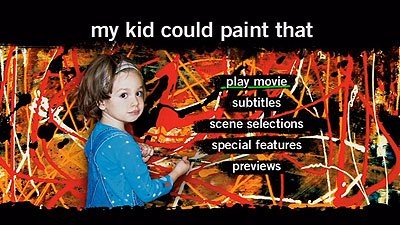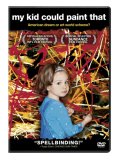| Reviews & Columns |
|
Reviews DVD TV on DVD Blu-ray 4K UHD International DVDs In Theaters Reviews by Studio Video Games Features Collector Series DVDs Easter Egg Database Interviews DVD Talk Radio Feature Articles Columns Anime Talk DVD Savant Horror DVDs The M.O.D. Squad Art House HD Talk Silent DVD
|
DVD Talk Forum |
|
|
| Resources |
|
DVD Price Search Customer Service #'s RCE Info Links |
|
Columns
|
|
|
My Kid Could Paint That

When filmmaker Amir Bar-Lev approached Mark and Laura Olmstead in August 2004 to pitch making a documentary about their four-year-old daughter who was enjoying modest media acclaim and commercial success as an abstract artist, Laura asked the prescient question "why would anyone agree to have a documentary made about them?" Bar-Lev replied "a documentary may get at a deeper truth . . . something you might like Marla to have twenty years from now." Likely, the only deeper truth the Olmsteads now think Bar-Lev's film reveals is the cynical nature of media and its catering to the public's insatiable desire for scandal. Though ultimately there's more to My Kid Could Paint That than an extended exercise in mudslinging, it's debatable how much more.
The story up until Bar-Lev's involvement goes like this: In early 2002, Mark, a night shift manager at a potato chip factory in Binghamton, NY and an amateur painter with little apparent talent, began encouraging two-year-old Marla to use oil paints on canvas. A year later, the Olmsteads displayed some of Marla's artwork at a local coffee shop owned by family friends. In August 2004, they signed Marla with local gallery owner Anthony Brunelli. Journalist Elizabeth Cohen then wrote the first article about Marla for Binghamton's Press & Sun Bulletin, attracting Bar-Lev's attention.
Bar-Lev documents the next twelve months of Marla's career which can be segregated into three periods: her rise, fall, and return. During her rise, Brunelli holds two successful exhibitions of Marla's work, and her story is picked up by the major media. The New York Times, NPR and several television infotainment programs do segments on her, The Today Show and Good Morning America get into a bidding war for an exclusive appearance, and The Gap and Crayola approach the Olmsteads about commercial endorsements. Between August 2004 and February 2005, Marla's artwork generates $300,000 in sales.
The media, having built up this four-year-old supposed prodigy, now tears her down. An exposé on 60 Minutes II shows footage of Mark directing Marla's efforts, and strongly infers that he actually paints the better pieces sold in her name. The market for Marla's paintings dries up immediately, and the Olmsteads and Brunelli are bombarded by negative press and hate mail.
The Olmsteads go on a counteroffensive releasing a DVD of Marla creating a painting from start to finish with no apparent help. The market for Marla's paintings revives and soars to new heights, and here Bar-Lev's documentary could have ended for the Olmsteads. Bar-Lev could have decided that My Kid Could Paint That was a comeback story about a family unjustly treated by a cynical media and an ugly public, but he didn't.
Apparently, Bar-Lev's faith in the Olmsteads was shaken by the 60 Minutes II exposé, and the last month of his time with the Olmsteads is spent attempting to prove definitively, but ultimately unsuccessfully, whether Marla was the sole creator of the artwork sold under her name. A confrontational interview with the parents ends with Laura in tears and Mark looking wretched, but no confession. Having failed to prove the matter either way, Bar-Lev throws up his hands and puts it to the viewers to decide through side-by-side comparisons whether the two paintings that Marla is known to have made on her own are of the same caliber as other pieces sold under her name. Clearly, Bar-Lev thinks they are not, and his opinion is shared by a majority of film critics who have reviewed this film. Roger Ebert, for one, unequivocally concludes "Marla didn't paint those works, although she may have applied some of the paint." On the other hand, a number of buyers and art critics believe that Marla was vindicated by the start-to-finish video record. LA Weekly art critic Doug Harvey concluded "the works created by Marla on camera are different from some of her canvasses, similar to others and better than many. Bar-Lev's big reveal is a bust, and turns what could have been a compelling inquiry into the machinations of the art market and media into a tawdry embarrassment."
Whether Roger Ebert's opinion about whether Marla created the paintings is worth as much as Doug Harvey's is an open question that goes to the heart of a second issue that Bar-Lev addresses: why is abstract art embraced by most art critics but still distrusted by the general public? Bar-Lev relies on New York Times senior art critic Michael Kimmelman to address this. Kimmelman argues that abstract art is still treated as a bit of a fraud by the general public because it lacks the more straightforward objective measures of quality found in, for example, photo-realistic paintings. Ebert echoes the popular skepticism in his comment that the only measure of some abstract art is its price tag: "At $25, it looks like dribbles. At $25 million, it looks like a masterpiece." While everyone is entitled to decide for themselves what art they like, and what they'd be willing to pay, are film critics or average viewers in as good a position as art critics to settle the nagging questions about authenticity raised here? Ebert suggests yes, Bar-Lev explicitly answers affirmatively, and Harvey and Kimmelman suggest no.
The DVD
The Video:
My Kid Could Paint That was recorded on high definition video. Some of the material looks unusually soft, but all post-production use of artwork looks extraordinarily crisp and vibrant. The anamophically-enhanced 1.78:1 image generally looks very good with no noticeable compression errors or distortions.
Removable yellow subtitles are available in English, French, Spanish, Chinese, and Thai.
The Audio:
The disc sports a high quality 5.0 audio mix.
The Extras:
The extras include a full-length optional audio commentary by Anthony Brunelli and film editor John Walter. Brunelli remorselessly plays up his own role in making Marla famous, while Walter discusses how the film was put together. Walter did not come into the process until after the principal photography was complete, so Bar-Lev's absence from the commentary is particularly disappointing.
There is also a 35-minute featurette entitled Back to Binghamton which includes deleted scenes, outtakes, and some Q&A's from film showings. Unfortunately, there is very little in the way of an update on Marla's story here.
Also included is a brief featurette Michael Kimmelman on Art consisting of extended outtakes from Kimmelman's talking head bits in the film. Kimmelman comes off very well and offers many interesting observations on both on the history and relevance of abstract art, as well as the subjective nature of all art including documentary filmmaking.
Finally, there's several previews for other Sony Pictures releases.
Final Thoughts:
Filmmaker Amir Bar-Lev started to make a film about a child prodigy, but he lost confidence in the legitimacy of his subject along the way. While he may well be correct that the four-year-old artist received help, he ultimately threw up his hands and left it to the viewer to decide. Only the Olmsteads will ever truly know. In any case, since the theatrical release of My Kid Could Paint That in October 2007, three more start-to-finish DVDs of Marla Olmstead at work have been completed, and the commercial value of her work continues to grow. Whatever help Marla may have once relied upon appears to be receding as her talents continue to mature. If Mark or Laura want to continue to provide a bit of help on a canvas, they may have to turn to their son Zane who at five years old may still welcome the assistance.
Regardless of one's opinions about Bar-Lev and the Olmsteads, My Kid Could Paint That is a fascinating exploration of a filmmaker who gets ensnared in his film when the floor shifts beneath him. My Kid Could Paint That is a highly recommended subjective documentary that shatters the fourth wall.
|
| Popular Reviews |
| Sponsored Links |
|
|
| Sponsored Links |
|
|
| Release List | Reviews | Shop | Newsletter | Forum | DVD Giveaways | Blu-Ray | Advertise |
|
Copyright 2024 DVDTalk.com All Rights Reserved. Legal Info, Privacy Policy, Terms of Use,
Manage Preferences,
Your Privacy Choices | |||||||












